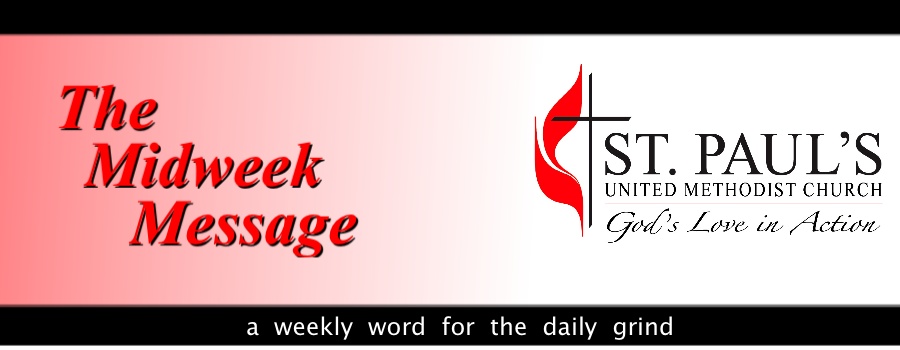October 2, 2012
Dear St. Paul’s Family,
I will always admit a certain nostalgic affection for the King James Version of the Bible. My very first Bible was a KJV: a brown, imitation leather edition given to me as a Christmas present by my father in 1978, when I was five years old. He purchased it with S&H green stamps, from the redemption store in our hometown. He wrote a dedication inside the front cover, which read:
Dearest Magrey, May you make His words in this Holy Book your guide in life from this day and hereon! And then he quoted the words of Proverbs 3:5-6: Trust in the Lord with all thine heart; and lean not unto thine own understanding. In all thy ways acknowledge Him, and He shall direct thy paths. Merry Christmas and Happy New Year! - Daddy.
The following year, when I was in second grade, I wrote these words on the next page, in that same Bible: I asked the Lord Jesus to come into my heart. Sept. 5, 1979 – Magrey deVega.
I still have that Bible on my shelf, of course, and though I rarely use it for personal study, I still open it to read my father’s dedication. His words, you’ve noted, are in the same style of Jacobean English as the King James Bible itself. My dad does not speak to me in that fashion, of course, but his written words communicated a kind of grand austerity that underscores why the King James Version is still so popular today.
WHAT’S IN A WORD?
Since then, I’ve moved through other preferences for biblical translations. I read the New American Standard Bible through most of my junior high and high school years. My home church had a steady supply of Good News paraphrases in its youth group meeting room. I finally settled on the New Revised Standard Version during college and seminary, which is the version that we had in our sanctuary prior to our fire.
There is value in referring to different translations when trying to interpret a text, just as it is wrong to believe that any one translation is more divinely superior than any other. All interpretation, after all, is a human endeavor, an imperfect effort at taking ancient words and placing them in contemporary contexts. Even Desiderius Erasmus, the 15th century Catholic priest and Christian humanist who translated the Greek into the Latin version that Martin Luther would later use in his German translation, admitted the limitations of translating a text: “Let them not drag me into court if the text does not agree with the original word for word, for, try as you may, it cannot be done.” (Erasmus, Apologia 170:20-1)
It may be hard for some to admit, but that is even the case for the beloved King James Version.
I’m reminded of a classic scene from the delightful British comedy The Vicar of Dibley, in which Alice, a sort of assistant deacon at the church, reads from a King James Bible during a worship service. The pages of that Bible were written in an Old English script, in which the “S’s” looked more like “F’s,” resulting in this embarrassing public recitation of Song of Solomon 6:2:
“Ye are the falt of the earth and fainted. God shall feal your endeavors until ye fit on his right hand. Therefore fight the good fight for his fake, and he shall be thy - - - .”
Needless to say, the vicar Geraldine interrupted her before she had a chance to mangle that final word, “succor.”
THE NEW BIBLE IN OUR PEWS
Well, so there is no one perfect translation of the Bible. But the new Bible in our sanctuary pews is one of the latest efforts to come up with a version that fuses the best of biblical scholarship with the accessibility of today’s reader. It is called the Common English Bible, published by Abingdon Press, the publishing arm of the United Methodist Church. Whereas our former New Revised Standard Version Bible is simply an updating of the old Revised Standard Version, which itself is merely an updating of the King James Version, the Common English Bible goes right back to the languages in which the Old and New Testaments were originally written. Seven hundred scholars and pastors, spanning twenty-four denominations, worked together to build a translation from the Hebrew, Aramaic, and Greek, making it resonant with today’s modern English.
When our prior pew Bibles were ruined by smoke last February, our insurance policy gave us full replacement value for replacing those Bibles. Rather than buying Bibles that matched our new ones, the Worship Committee considered the new translation and was quickly sold by its more accessible language, along with the larger print and decorative cover that matched our sanctuary décor.
We believe that the new Bibles will serve St. Paul’s for generations to come, and will strengthen one of this congregation’s core values: “To be a People of the Word: We share a foundation in the written words of the Bible, and a passionate devotion to the living Word in Jesus.”
Together, let us live into the words of Proverbs 3:5-6, in the language of the new CEB: Trust in the LORD with all your heart; don’t rely on your own intelligence. Know him in all your paths, and he will keep your ways straight.
Grace and Peace,
Magrey
The Rev. Magrey R. deVega
St. Paul's United Methodist Church
531 W. Main St.
Cherokee, IA 51012
Ph: 712-225-3955
Email: mdevega@sp-umc.org
WORLD COMMUNION SUNDAY
We join together in our annual observance of our mutual connection to Christians all around the world with our World Communion Sunday service. We will also be taking up a special offering that funds scholarships for ministry-related students attending Methodist schools around the world. This is one of six offerings required by the Discipline and the proceeds help our Rainbow Covenant Missions effort for this year.


No comments:
Post a Comment